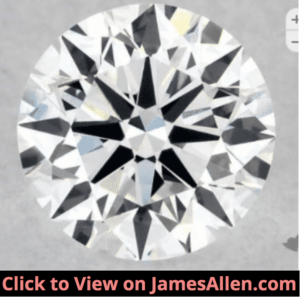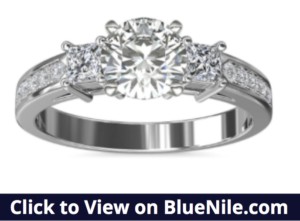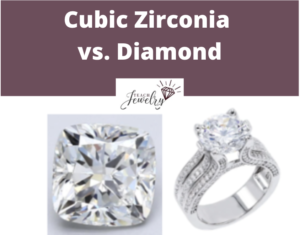
Cubic zirconia and diamond are two popular types of gems, but confusing the two would be a costly mistake.
The main difference between cubic zirconia (CZ) and diamond is CZ is grown in a lab from zirconium dioxide, while diamonds are crystalized carbon formed naturally. CZ is a diamond simulant, and its per-price-carat is far less than an earth-mined diamond.
In this guide, I’ll give you an overview of cubic zirconia and how it compares to a diamond in areas such as:
- Composition
- Origin
- Price
- Color
- Distinguishing one from the other
- Deciding between them
What is Cubic Zirconia?
Cubic zirconia is a synthetic gemstone made from the cubic crystalline form of zirconium dioxide. It’s made by applying intense heat to zirconium oxide powder, combined with magnesium and calcium, which act as stabilizers.
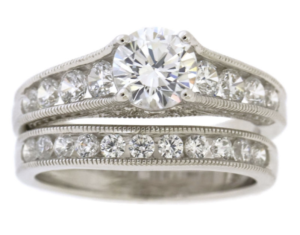
Once it’s removed from the 4,800 degrees Fahrenheit heat, the crystals are polished and cut. They’re turned into familiar shapes such as princess, emerald, round, pear or cushion cut. The final product is almost always colorless, but you can find colored versions as well.
Cubic zirconia isn’t a real diamond. It’s the most common diamond simulant due to its close resemblance to a real diamond, but they’re made in a lab.
It’s also not the same as a lab-created diamond. Lab-created diamonds have the same physical properties of natural diamonds (carbon), while cubic zirconia doesn’t have carbon.
Differences Between Cubic Zirconia and Diamond
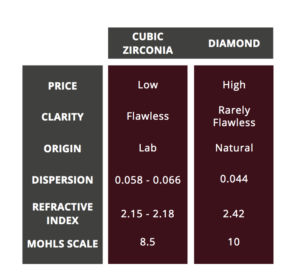
1. Composition and Durability
Don’t be fooled by cubic zirconia and diamond having a similar appearance. Their composition isn’t the same at all.
Diamond is composed of only the element carbon. It’s rated a perfect 10 on the Mohs scale of hardness, meaning it’s the hardest naturally-occurring material known to man.
Cubic zirconia, on the other hand, is rated an 8.5, which is lower than sapphire and moissanite.
You can expect a diamond to maintain its quality and sparkle for a lifetime, but cubic zirconia is more easily scratched and can become cloudy after a few years of use.
If you wear it every day, don’t expect it to be in top shape for more than a few years, but if it’s only for occasional use, it could be a long-lasting piece of jewelry.
Both require maintenance, but maintaining a diamond is more about protecting your high-value asset and ensuring it performs at its highest potential.
Comparing both composition and durability, diamonds are the clear winner.
2. Origin
Diamonds originate naturally in the earth and in labs. Mined diamonds are the most expensive because high-quality ones can’t just be created in a lab in an unlimited capacity.
They’re commonly used as the center gem in engagement rings.
It’s rare to find diamonds that score highly across the four Cs (color, cut, clarity, and carat). When they’re discovered, they sell at a premium.
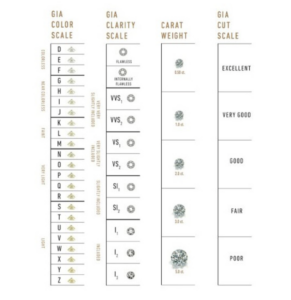
Like a synthetic diamond, cubic zirconia is also created in a lab. There have been instances of cubic zirconia appearing naturally in the mineral baddeleyite, but this isn’t their standard origin.
If you’re buying cubic zirconia, you can be almost certain it was created in a lab.
3. Price per Carat
It’s important to know the differences in prices between cubic zirconia and diamond and why there’s such a gap. The reasons cubic zirconia is significantly cheaper than diamond is because they’re grown in a lab, don’t occur naturally, and there isn’t nearly as high of a demand.
Let’s compare the price of an engagement ring featuring cubic zirconia versus a diamond.
This 1.5 carat round cubic zirconia engagement ring costs $49.
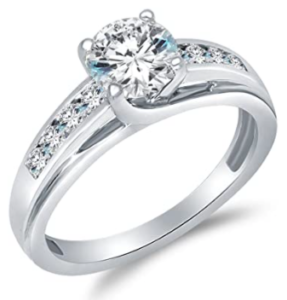
This engagement ring diamond with the same carat weight, color, and cut costs $14,850.
As you increase the carat weight of each gem, the price of the cubic zirconia would not rise significantly. You might pay a few hundred dollars for one approaching three or four carats.
If you were to buy a three- or four-carat diamond with identical color and cut, you’d likely pay more than $30,000.
The same principles are true when it comes to a resale. You can expect minimal return if you sell cubic zirconia — the same experience you’d have trying to resell any diamond simulant.
Diamonds retain more of their value because of their durability and rarity, but that doesn’t mean they’re an investment or you should expect a serious payday when you sell it. For both diamonds and cubic zirconia, don’t make the initial purchase with the resale value at the forefront of your mind.
4. Color
The color of diamonds is measured along the GIA scale from colorless (grades D-F) all the way to light yellow (S-Z), with nearly colorless, faint yellow, and very light yellow in between.
Colorless gems are more valuable than ones with yellow or fancy colored gems such as champagne, blue, or black diamonds. That’s because truly colorless diamonds are incredibly rare and give off the most sparkle.
Most cubic zirconia actually scores higher in the color category than diamonds, but they’re intentionally manufactured that way. They aren’t considered more valuable because of their lack of color. That’s standard for cubic zirconia.
A colorless diamond is rare and commands a higher price.
Cubic zirconia doesn’t only come colorless. There are also fancy color versions such as red, purple, green and blue. These can be made to resemble sapphires, emeralds, and other types of gems.
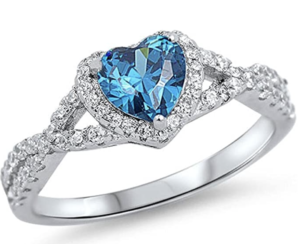
When choosing a colored version of cubic zirconia, you don’t have to worry about what color does to the price because colorless versions don’t sell at a premium anyway.
5. Clarity
Comparing diamond versus cubic zirconia in regard to clarity is similar to comparing their color.
Clarity refers to the color, position, and degree of inclusions in a diamond. These inclusions are defects within the diamond that inflicted it during formation. Examples of inclusions are feathers, crystals, and cavities.
Fewer inclusions, and ones that are less noticeable, increase the value of a diamond.
Because cubic zirconia is manufactured in a lab, they can be produced without inclusions. That means it doesn’t have natural imperfections. So if you compare diamond and cubic zirconia on that one dimension, cubic zirconia wins almost every time.
The solution for someone buying a diamond is to find one that’s “eye clean,” meaning you can’t see any inclusions unless it’s under magnification. Anything very slightly included (VS1 or VS2) are a safe bet.
6. Dispersion (Fire)
Dispersion refers to how white light enters a diamond and then bounces back to the viewer’s eyes. It’s determined by the quality of the diamond’s cut, which involves fashioning the stone and its facets in a way that its polish, symmetry, and proportions have the best light performance. A diamond with a quality cut will only reflect white light, which is more desirable.
Cubic zirconia disperses light at a higher rate than a diamond (0.066 versus 0.044). While that may sound like cubic zirconia has better light performance, in this case, it actually results in a “rainbow effect” because it reflects so much colored light. This is a less desirable quality in a gem, so it’s generally not viewed as a positive.
The rainbow effect is a result of cubic zirconia having a lower refractive index (RI). RI refers to the angle light enters the stone and is then reflected off it. For cubic zirconia, it’s between 2.15-2.18, and for a diamond, it’s around 2.42.
A higher RI means light travels faster through the diamond and back to the viewer’s eyes.
7. Density
Cubic zirconia is more dense than a diamond. If you compare it with a diamond of the same size, it’s heavier. One carat of cubic zirconia would look smaller than a one-carat diamond.
That’s one way a jeweler can test whether it’s cubic zirconia or a diamond. They’ll compare it to the size of a one carat diamond, and if it’s larger, that’s an indicator it’s not a real diamond.
How to Tell the Difference
White vs. Rainbow Light
The easiest way to tell the difference is to look at each gem under natural light. A diamond’s brilliance will give off white light, while the cubic zirconia will have a rainbow glow, as a result of excessive light dispersion.
Weight
In general, cubic zirconia weighs 1.7 times as much as a diamond.
Because cubic zirconia is more dense, you can distinguish it from diamond if you have one of the same weight to compare to. If you know both are two carats, but one gem is larger than the other, it’s likely the smaller one is cubic zirconia.
Smooth vs. Sharp Edges
Diamonds are cut with sharp edges to give better light performance. The individual facets are cut into the diamond with close precision in a way that increases its value.
On the other hand, cubic zirconia has smoother and more round edges. You’ll need magnification for this test, but it’s another way to tell the difference.
Fog Test
The fog test works the same way you fog a mirror. Breathe into each gem. Cubic zirconia will remain foggy for several seconds, while the fog won’t remain in the diamond. This is because diamonds have better thermal conductivity, which is the next test.
Thermal Conductivity
Thermal conductivity is arguably the most reliable way to tell the difference between cubic zirconia and diamond. This is because diamonds conduct heat, and most diamond simulants don’t.
If you need certainty and take it to a jewelry store, it’s likely the jeweler will use a diamond tester, so you know you have the most reliable result.
How to Decide Between Cubic Zirconia and Diamond
If you’re deciding whether you want to buy cubic zirconia or a diamond, compare them across all their main qualities and determine which one is right for you.
If you’re looking for an inexpensive, functional gem that can complement more casual outfits, spending anywhere from $20 to a few hundred dollars on cubic zirconia could be the right choice. It has a shiny look with no inclusions and to the naked eye, it can look like a diamond.
But don’t be fooled into thinking cubic zirconia is in the same class as a diamond. It’s a simulant created in a lab, and there could be thousands of the exact same gem. There isn’t often uniqueness to cubic zirconia.
Diamonds, on the other hand, are valued for their individuality, rarity, and natural origin.
You’ll want to spend significantly more time diamond searching for the right diamond, whether it’s for an engagement ring or another piece of jewelry. It’s a more expensive purchase, and there’s nothing like finding the perfect diamond that completes your style.

Jacob Clarke
Jacob Clarke is the founder of TeachJewelry.com.
He earned an Applied Jewelry Professional Diploma from the Gemological Institute of America (GIA) and now brings you essential information about diamonds, settings, and more.
Jacob has consulted with leading jewelry brands, and his work has been cited in Clean Origin, Diamond Nexus and industry publications.
He's also a member of the International Gem Society.
He enjoys discussing jewelry with readers, so contact him with any questions at jacob.clarke@teachjewelry.com.

